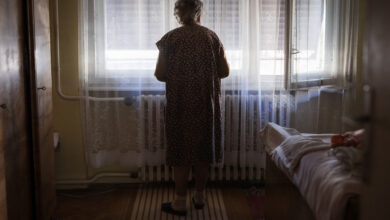Isn’t it time we took incontinence seriously?

Over five million Australians aged 15 years and over suffer with bladder or bowel control problems, a figure predicted to grow to 6.5 million by 2030, and people with incontinence suffer long-term physical and emotional impact and rarely seek help.
In 2010, total health system expenditure on incontinence in the Australian population was estimated at $271 million or $57 per person with incontinence, which was projected to rise to $450 million by 2020.
While the total financial cost of incontinence, taking into account loss of productivity, carer costs among other costs was estimated to be $66.7 billion in 2010.
Aged care alone contributes $1.6 billion to that figure.
In total, approximately 21 per cent of the community population have urinary or faecal incontinence, or both. That rate jumps to 70.9 per cent for aged care residents, and evidence from the royal commission suggests that this is a problem that is often untreated.
Aged Care Insite sat down with Rowan Cockerell, chief executive of the Continence Foundation of Australia to talk more about the issue.
ACI: The Royal Commission said in its final report that it heard 71 per cent of people in residential aged care have experienced incontinence. Why is this problem persisting?
RC: Incontinence is common across the Australian population and is prevalent in the elderly and consequently also among those living in residential aged care facilities. Unfortunately, there is a general lack of awareness that incontinence is a preventable and treatable condition. A lot of people think that it is a symptom of ageing and as such there isn’t anything that can be done. However, this is not the case and with proper support, people can improve and manage their incontinence.
There is also an element of stigma associated with incontinence. People don’t tend to raise it openly, even in a health care setting, so by the time they are entering aged care people are often resigned to their incontinence. We also know that once in aged care most incontinence persists and becomes worse.
Unfortunately, as evidenced within the Royal Commission, incontinence and continence care is not managed well in most residential aged care. Despite this, the Royal Commission’s final report only included one recommendation relating to incontinence. Recommendation 19 – calling for an urgent review of the Aged Care Quality Standards, to raise the bar in terms of best practice continence care, amongst other conditions.
Recommendation 78, while not mentioning continence care, focused on workforce support and the lack of knowledge and training within the personal carer workforce which is fundamental in ensuring safe and effective continence care and incontinence management moving forward.
The Certificate III in Aged Care, which is the most relevant qualification for workers in the sector, does not currently include a unit of competency in continence care. This omission along with the lack of awareness and stigma are clearly reasons for the high prevalence in aged care.
There is a solution to this. If we continue to build awareness, start conversations to reduce stigma and equip the workforce with more education and knowledge, we are sure to see better continence care and better health outcomes for not just the elderly living in aged care but all people.
The Royal Commission report said: "The evidence indicates that some residential aged care providers unintentionally contribute to incontinence by adopting flawed approaches to its management." What are we not doing, or doing wrong, that is causing this problem to persist?
Incontinence in residential aged care is a multifaceted issue. It can often be prevented and treated, or better managed even in frail older people.
The causes of increased incontinence in people living in residential aged care can be associated with a number of issues. These can include care management plans that promote the use of incontinence products only, rather than the provision of toileting assistance, a lack of specialised education and training, and a lack of staff resources and time. All of these contribute to containing the urinary and faecal incontinence rather than supporting that person to be as continent as possible.
A lack of specialised education and training also has a key role in perpetuating improper incontinence management. The Royal Commission’s recommendations for increased staff time per resident will help, but central to this is that care staff need to understand the importance of person-centred continence care and be able to deliver that care.
What physical effects can ignoring incontinence cause?
The physical effects of unsafe and ineffective continence care and incontinence management are startling and can be costly to both the individual and aged care and hospital systems. Consequences may include an increased risk of UTIs, incontinence-associated dermatitis, pressure injuries, pressure injuries not healing, falls, depression and acceleration of functional decline.
What are the things we should be doing to fix it?
Firstly, we need to prioritise continence care. There was a total of 148 recommendations in the Final Report but, as mentioned, only one relating to incontinence.
In its workforce submission to the Royal Commission, the Foundation recommended that all staff and health professionals working in the aged care sector should receive education about safe and effective continence care and incontinence management in their foundation courses (VET and undergraduate courses). There is a clear link between better health outcomes and better-educated health care workers.
In Recommendation 19, the Royal Commission recommended a review of the Aged Care Quality Standards to raise the bar for best-practice continence care. The Foundation is prepared to support this initiative with our best-practice Model of Continence Care (MoCC) for residential aged care. The Model is in the final stages of development and mapped against current aged care standards. It will give aged care providers the detailed guidance they need on how to achieve safe, quality and dignified continence care.
In addition to this, the Continence Foundation has a combination of low-cost and free learning modules available for aged care staff and facilities. We also operate the National Continence Helpline (1800 33 00 66) staffed Monday to Friday, 8am to 8pm by nurse continence specialists, and Continence Support Now, a website that allows care workers to quickly look up continence care issues and be provided with tips and advice.
We know that depression is a big issue among residential aged care residents. This must be contributing to that as well as an overall loss of dignity.
Yes, we know that incontinence is a predictor for depression and anxiety. The relationship between incontinence and mental health is not well understood or acknowledged within wider health and mental health sectors.
Dignity is the cornerstone of the Model of Continence Care the Foundation has developed and can certainly be preserved with good continence care. Quality of life and dignity is dependent on safe care and support to toilet effectively.
In 2010, incontinence was estimated to cost Australia 67 billion dollars annually. Can you break that figure down?
In 2010, we commissioned Deloitte to investigate the economic impact of incontinence in Australia and the report estimated it at 67 billion dollars annually, with burden of disease in monetary value making up $23.8 billion.
The remainder was health system expenditure on incontinence in the Australian population (271 million), productivity losses of people with incontinence who have lower than average employment rates (34.1 billion), productivity losses of carers (2.7 billion), formal care and aids costs (1.96 billon), and deadweight losses (3.8 billion).
This won't be one of the more publicised issues when we are discussing fixing the sector, but it is these smaller things that add up to really good care. What would you say to providers and the government when it comes to incontinence?
The Continence Foundation considers continence care as one of the cornerstones of fundamental care that respects and focuses on a person’s essential needs to ensure their physical and psychosocial wellbeing.
Unsafe and poor-quality continence care was one of the top five most complained about issues brought to the attention of the Royal Commission. Safe, effective and funded continence care is essential to combat the horrifying accounts of inappropriate continence care heard.
The Foundation strongly believes continence care and incontinence management needs to be person centred, provide choice and maintain dignity. This is a right of all Australians accessing aged care services and we would like to emphasise this to providers and government.
While the Royal Commission didn’t make mention of it, we know that incontinence is a driving factor in people going into aged care and that it gets dramatically worse once people are there. We believe it is a significant issue that has been sadly overlooked.
The Continence Foundation is committed to getting the issue of incontinence care provided with dignity back on the agenda within the reform to take place. The Foundation released an open letter to the Minister for Senior Australians and Aged Care Services Richard Colbeck, calling for a focus on continence from the Morrison Government and funding to develop a National Strategy on Incontinence.
The Foundation’s proposed National Strategy on Incontinence focuses on four key areas: maximising national awareness, boosting workforce capacity, economic participation and ongoing research. With a National Strategy on Incontinence and the development of best-practice Model of Continence Care for aged care, the Foundation aims to improve continence care for older Australians.
Email: [email protected]





